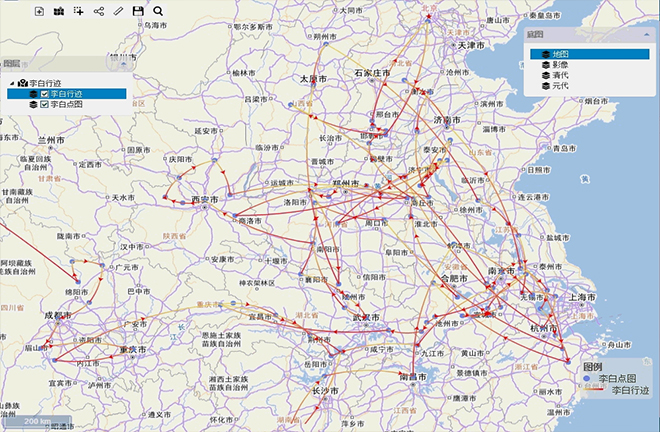Digital humanities uses data to deepen literary research

A digital life map of Tang Poet Li Bai (701–762) on the Academic Map Publishing Platform Photo: ZJU
In recent years, the integration of literary research and the digital humanities has brought about a batch of refreshing academic achievements. What “chemical reaction” was sparked through this unique combination? What are the prospects of digital literature research?
Academic circles have not yet reached a consensus on how to define the digital humanities, of which the connotations and extensions need to be constantly enriched and improved. In general, its purpose is to use information technology to upgrade and transform the traditional humanities, and to find research objects and topics that were difficult to discover in the pre-digital era, said Zheng Yongxiao, a research fellow from the Institute of Literature at the Chinese Academy of Social Sciences (CASS).
The digital humanities involves academic teams with multidisciplinary backgrounds fully utilizing data to conduct humanities studies with the support of platforms and digital technology, said Wang Zhaopeng, a professor from the School of Literature, Journalism and Communication at South-Central University for Nationalities.
The digital humanities has greatly liberated researchers from piles of documents. Nowadays, a variety of formats including images, sounds, videos and comprehensive texts can be digitized for building a complex but orderly big data platform, said Ling Jianhou, director and a professor of the Institute of World Literature at the School of Foreign Languages, Peking University.
Traditional literary research mainly involves a relationship between subjective interpretation and objective literature. Data is occasionally used, but merely serves as a supplement, Wang added. In contrast, the digital humanities converts historical documents into data and treats the data as the basis for further analysis. How to transform data and what kind of data to transform depend on the purpose of researchers and their understanding of historical data. This means that the digital humanities remain similar to traditional literary studies at the conceptual level, although completely different at the operational level.
The digital humanities has methodological significance for literary research. For example, lacking the support of databases, past research of ancient literature could only select representative writers and their works for case studies. The establishment of databases allows for the collection of all available documents in a specific field, extending the depth and breadth of related research. The automatic word segmentation and statistical functions of computers make it possible to find problems that are difficult to discover in traditional research paradigms, Zheng said.
In the digital humanities era, the literary and art theory and literary criticism are also being impacted by data-driven thinking. For example, the “macroanalysis approach” of Matthew L. Jockers, a professor of English and data analytics at Washington State University, and the “distant reading method” by Franco Moretti, an Italian literary historian and theorist, are new digital humanities creations. The former approach involves the application of the research methods of natural sciences such as biology and chemistry to analyze the formal elements of best-sellers. The latter approach mainly adopts quantitative empirical methods and big data processing, featuring a new positivist approach where the humanities field is in line with the features of the internet and the big data era, Ling explained.
Over the past decade, a number of eye-catching achievements have been made in integrating the digital humanities and literary research. The Tang and Song Poet Life Map Platform developed by South-Central University for Nationalities takes advantage of Geographic Information System technology to realize the visualization of literary research results and the trajectories of the lives of poets. Many other fruits of the digital humanities also deserve our attention, including the Academic Map Publishing Platform co-built by the Academy of Humanities and Social Sciences at Zhejiang University and the Center for Geographic Analysis at Harvard University, and the Digital Analysis Platform for Song Dynasty Literature Map by the CASS Institute of Literature.
On the whole, digital literature research has advanced from a series of attempts to an actual initial stage. However, it still faces certain limitations. Current academic evaluation mechanisms pay insufficient attention to the results of the digital humanities. Results produced by an academic team may even be rejected due to multiple authors. In addition, visualization results cannot be displayed in most publications, thus limiting further digital literary research.
In terms of the digital humanities trend represented by literature studies, Zheng added that the application of technology and data thinking are certainly a tendency, but the digital humanities is not a panacea and cannot replace all traditional research approaches. The digital humanities should not emphasize data over the humanities itself. Further attention should be paid to maintaining the fundamental attributes and basic features of the humanities.
edited by YANG LANLAN
